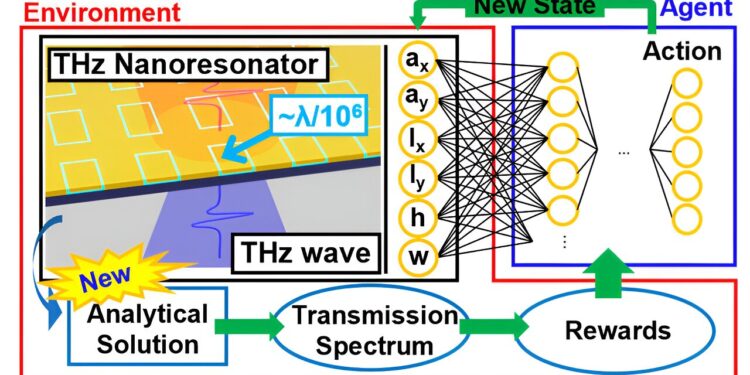Graphical summary. Credit: Nano letters (2023). DOI: 10.1021/acs.nanolett.3c03572
A team of researchers led by Professor Hyong-Ryeol Park from the Department of Physics at UNIST has introduced technology capable of amplifying terahertz (THz) electromagnetic waves by more than 30,000 times. This advancement, combined with artificial intelligence (AI) based on physical models, is poised to revolutionize the commercialization of 6G communications frequencies.
In collaboration with Professor Joon Sue Lee from the University of Tennessee and Professor Mina Yoon from Oak Ridge National Laboratory, the research team successfully optimized the THz nano-resonator specifically for 6G communication using with advanced optimization technology.
The research results were published in the online version of Nano letters.
By integrating AI learning, based on a physical theoretical model, the team enabled the efficient design of THz nano-resonators on personal computers, a process that was previously time-consuming and demanding, even with supercomputers.
Through a series of THz electromagnetic wave transmission experiments, the team evaluated the effectiveness of the newly developed nano-resonator.
The results were astounding, with the electric field generated by the THz nano-resonator exceeding general electromagnetic waves by more than 30,000 times. This achievement represents an incredible efficiency improvement of more than 300% compared to previously reported THz nano-resonators.
Traditionally, AI-based inverse design technology focused on designing optical device structures in the visible or infrared regions, which were only a fraction of the wavelength. However, applying this technology to the 6G communications frequency range (0.075 to 0.3 THz) has presented significant challenges due to the much smaller scale, approximately one millionth of the size of the length of wave, Professor Park explained.
To overcome these challenges, the research team designed an innovative approach by combining a novel THz nano-resonator with an AI-based inverse design method based on a physical theoretical model. This approach allowed the device to be optimized in less than 40 hours, even on personal computers, compared to the dozens of hours previously required for a single simulation or potentially hundreds of years for optimization of a single device.
Researcher Young-Taek Lee (UNIST Department of Physics), first author of the study, highlighted the versatility of the optimized nano-resonator, highlighting its implications for ultra-precise detectors, ultra-precise molecular detection sensors small and bolometer studies. He added: “The methodology employed in this study is not limited to specific nanostructures but can be extended to various studies using physical theoretical models of different wavelengths or structures. »
Professor Park highlighted the importance of understanding physical phenomena in conjunction with AI technology, saying: “Even though AI may seem like the solution to all problems, understanding physical phenomena remains crucial. »
More information:
Hyoung-Taek Lee et al, More than 30,000-fold field enhancement of terahertz nanoresonators enabled by rapid inverse design, Nano letters (2023). DOI: 10.1021/acs.nanolett.3c03572
Provided by UNIST
Quote: Revolutionary technology amplifies terahertz waves for 6G communication (December 22, 2023) retrieved December 22, 2023 from
This document is subject to copyright. Apart from fair use for private study or research purposes, no part may be reproduced without written permission. The content is provided for information only.



